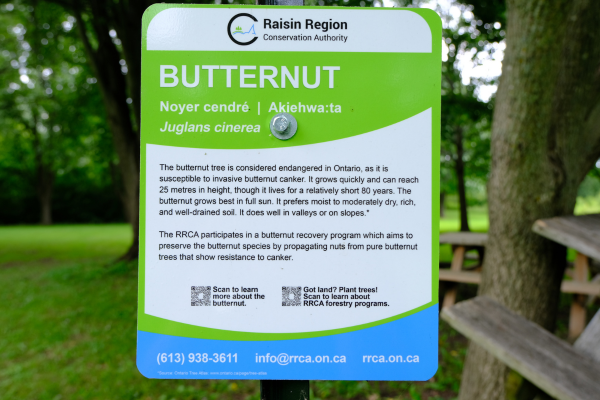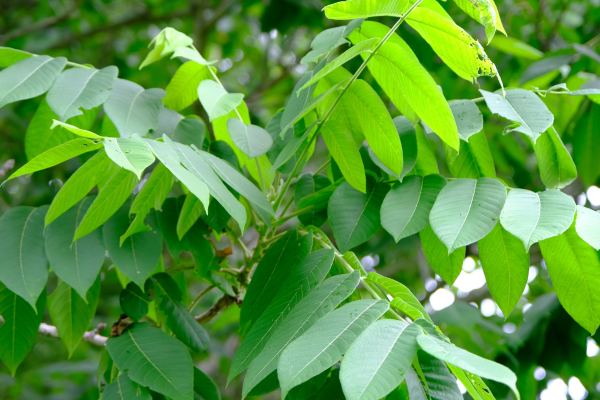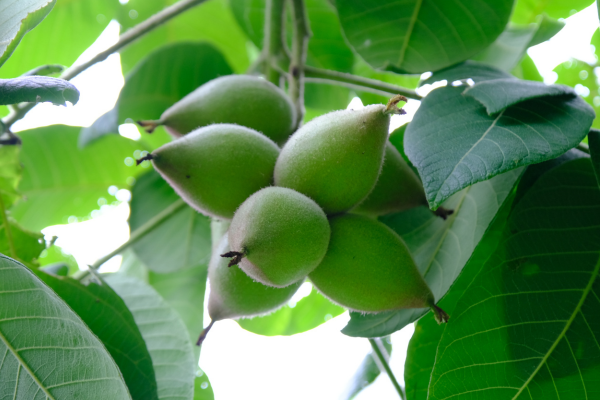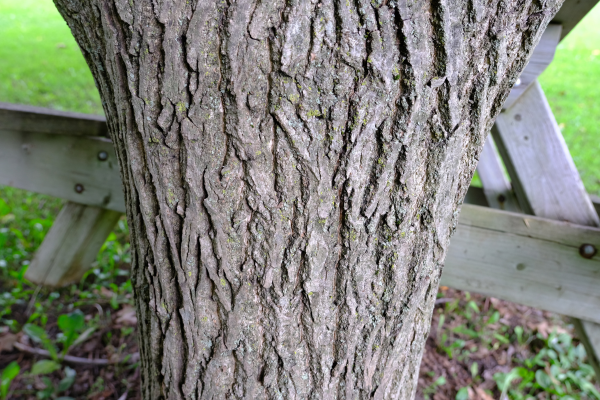The RRCA is compiling a waitlist for property owners interested in participating in the spring 2025 Butternut Recovery Program. Please contact the RRCA for more details at (613) 938-3611 or info@rrca.on.ca.
Scientific name: Juglans cinerea
Juglans = Combines the Latin word Ju reffering to Jupiter, the Roman king of the gods and glans meaning “nut”. It is said that nuts, specifically walnuts, were considered food of the gods and eaten atop Mount Olympus.
cinerea = Derived from a Latin adjective meaning “ash-like” or “ash-coloured” referring to the ash grey colour of the tree’s bark.
A member of the walnut family, butternut trees can be found scattered across most mixed and deciduous forests in southern Ontario except for the Bruce Peninsula and Manitoulin Island. These trees produce large, sharply ridged nuts, that contain a single seed encapsulated by a light green, sticky, and elongated husk. This fruit is a food source for birds, squirrels, and other small mammals. Butternut trees are relatively short lived and have seen a steep decline in recent years. The main culprit of this decline is Butternut Canker, a fungal disease that can spread quickly throughout the trees and kill them within a few years. The diseased areas, called “cankers”, develop under the bark and can, in effect, strangle the tree, cutting off the circulation of water and nutrients. Butternut trees are now considered an endangered species and are protected by the Endangered Species Act. To see more information on recovery strategies visit the Ontario page Butternut (Species at Risk) or for more information about the Ontario's Invading Species Awarness Program article on Butternut Canker.
Butternut trees can tolerate moist to moderately dry soils, though prefers a moister soil. They grow best in well-drained, rich soils in valleys or on slopes. These trees are shade intolerant and need full sun. In the wild, these trees are often seen growing in sunny openings of forests or near their edges to get their required sun level.
In the past, wood from Butternut trees was used to make cabinetry, furniture, and veneer. They were also grown and cultivated for their edible nuts, which are valued for their buttery taste. These nuts can be eaten on their own or mixed into breads, sauces, and other dishes. The husks and bark of Butternut contain a tannin that, when boiled, can create a yellow-brown dye for fabric or for making ink, which can stain your hands for weeks! Indigenous people also used Butternut medicinally to treat toothaches, injuries, and digestive problems. Check out "Cracking Butternuts or White Walnuts Juglans cinerea" to see what these nuts look like.
Sources:
Indiana Nature LLC. 2023. Juglans cinerea - Butternut. [online] Available: https://www.indiananature.net/pages/taxa/Plantae/j/Juglans_cinerea.php
OFAH/OMNRF Invading Species Awareness Program. 2021. Butternut Canker. [online] Available: https://www.invadingspecies.com/invaders/forest/butternut-canker/
OMNR, 2022. Ontario Ministry of Natural Resources: Ontario Tree Atlas. [online] Available: https://www.ontario.ca/page/butternut
OMNR. 2021. Butternut Canker. [online] Available: https://www.ontario.ca/page/butternut-canker
University of Guelph. The Arboretum: Butternut (Juglans cinerea). [online] Available: https://arboretum.uoguelph.ca/thingstosee/trees/butternut
%20938-3611%20info%40rrca_on_ca%20rrca_on_catrees%20(400%20%C3%97%20200%20px)%20(1).jpg)


 Want to plant butternut trees on your property, ask about the RRCA’s Butternut Recovery program!
Want to plant butternut trees on your property, ask about the RRCA’s Butternut Recovery program!  Butternut leaves are compound, made up of 11 to 17 leaflets, ovular and measuring between nine and 15 cm long.
Butternut leaves are compound, made up of 11 to 17 leaflets, ovular and measuring between nine and 15 cm long.  Nuts are contained in a light green, sticky, husk. This husk is more elongated than those of black walnut, a useful indicator for identification.
Nuts are contained in a light green, sticky, husk. This husk is more elongated than those of black walnut, a useful indicator for identification. Mature trees have bark with narrow dark fissures and wide flat-topped ridges.
Mature trees have bark with narrow dark fissures and wide flat-topped ridges.